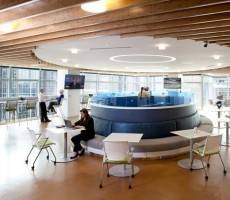October 10, 2014
Case study: A public sector building that lights the way ahead for others
Last year, I had the pleasure of producing a case study of the new offices of Wiltshire County Council for Mix Interiors magazine. Given that the building was this week shortlisted for the Prime Minister’s Better Public Buildings Award and had already won an award from the BCO, we thought this seemed a good time to retread its corridors of power…. The recession has led the UK government to develop a number of new approaches to public sector buildings. But some of the UK’s local authorities are way ahead of the new thinking. Even so, there was a time, not so long ago, when nobody worried too much about the shape of the rooms that led off the corridors of power. But the pressure on UK public finances has politicised the design of the UK’s public buildings, with the government launching a wide range of initiatives to improve the efficiency of the way public sector acquires, designs and runs the places it calls home.

























September 5, 2014
Workplace design is increasingly interwoven with the dynamics of the city
by Colin Watson • Comment, Facilities management, Workplace design
More →